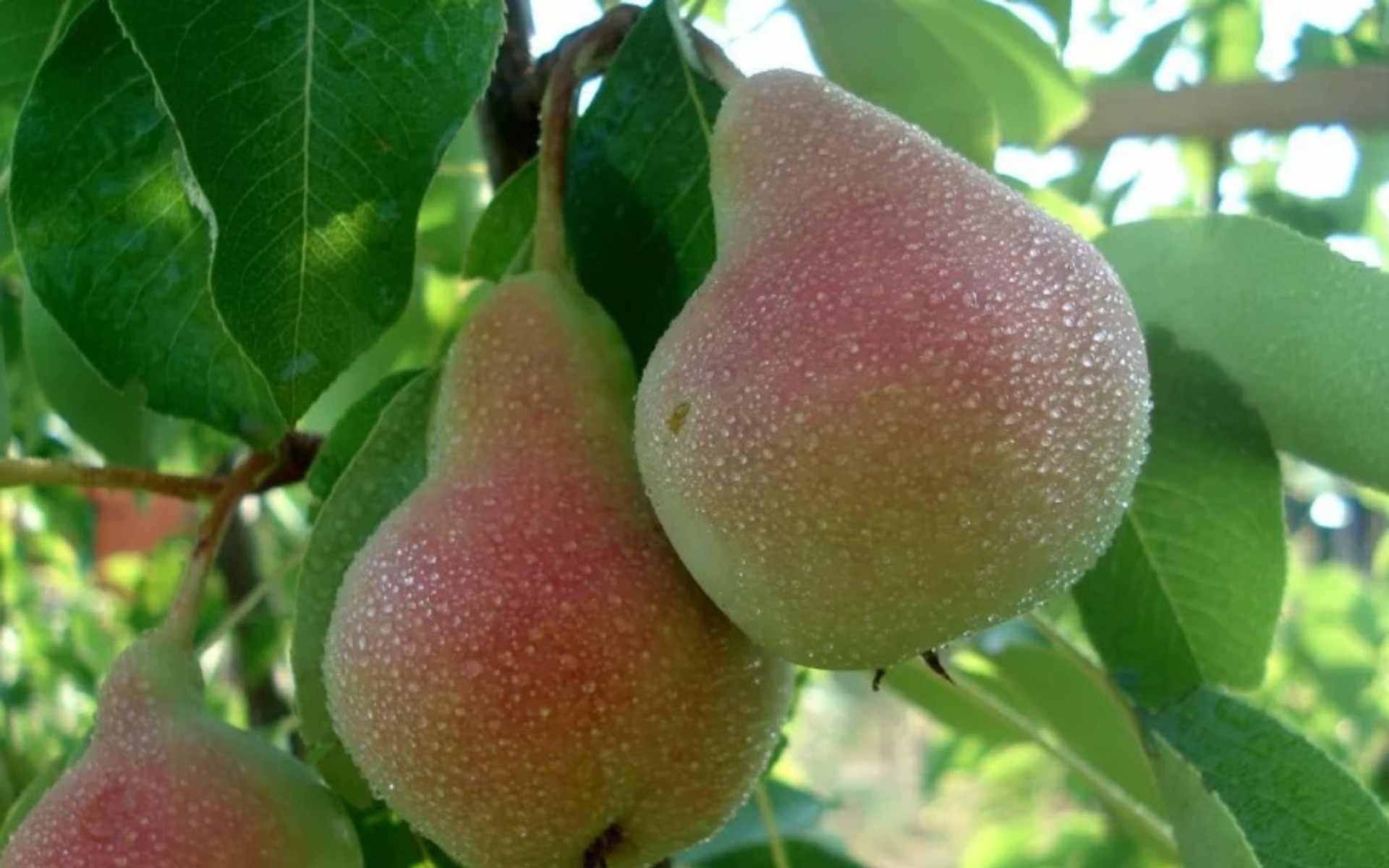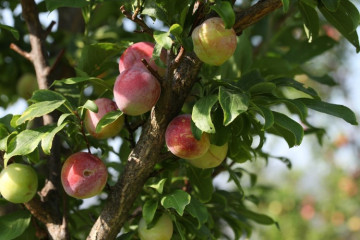Pear Forest beauty: description of the variety of fruit trees
Content:
Pear Forest Beauty is a popular crop variety characterized by high and stable yields, as well as excellent fruit taste. This species became the basis for more than 30 new varieties. Pear Forest beauty fully lives up to its name. It has increased resistance to adverse factors, like a wild game, but at the same time the appearance of the fruit meets the requirements of even the most demanding gardeners.
Breeding history
According to the current version, the native land of this species is Belgium. It was discovered at the beginning of the 19th century by the Flemish Chatillon while walking in the woods in the vicinity of Alost. An unusual tree attracted his attention with its spreading crown and juicy large fruits. Soon the forest beauty pear became widespread in many European countries.
According to the gardener A.S. Grebnitsky, the Forest Beauty pear was obtained by the Belgian breeder Fario in the city of Deftingen. And Professor Jean-Baptiste Van Montsou contributed to the massive spread of this variety, since it was he who developed the methods of transporting seedlings to all corners of the world.
This variety is not included in the State Register of Russia. It shows maximum efficiency in the conditions of the North-West and Lower Volga regions. But, judging by the reviews of gardeners, the Forest Beauty shows a stable yield also in the conditions of the Moscow region.
Description of the variety
According to the description of the variety, the height of the Forest Beauty pear reaches 5 m. The tree has a wide pyramidal crown shape. Its branches are slightly inclined downward. During fruiting under load, they can sink to the ground. The leafiness of this pear variety is medium. Most of the crop is formed on branches that are 3-4 years old.
The shoots of the Forest Beauty are thick, strong. The surface of the branches is dark reddish in color, on it there are a few medium-sized lentils. The buds are small with a metallic shade.
The leaves of the Forest Beauty are small, ovoid. The plates are bright green in color, and along the edge they have finely serrated irregularities. They are attached to the branches with thin, long petioles.
Flowers are small, they can be single or collected in inflorescences of 3-5 pcs. The color of the petals is pale pink. The forest beauty pear is a partially self-fertile species. In the absence of additional pollinators, the ovary is within 70-75%.
Therefore, to increase yields, it is recommended to plant other varieties of crops nearby. Best suited for this:
- Seedless;
- Lemon;
- Williams;
- Clapp's favorite.
The fruit is ovoid with a blunt tip. The average weight of one pear varies in the range of 130-160 g. The skin is thin, dense, there is a slight roughness on the surface.At the stage of technical maturity, the fruits are green with a slight yellow tint. And when fully ripe, they become golden. On the sunny side, the pears have a reddish blush.
The peduncle is thickened, strong, slightly expanding at the top. The funnel is narrow, small, the saucer is wide, smooth. The core of the fruits of the Forest Beauty is fusiform, slightly outlined with small grains. Teardrop-shaped seeds are dark brown in color, concentrated in ovoid, closed chambers.
The pulp of ripe fruits is juicy, sweet, white or beige. She has a delicate, melting structure.
Specifications
This variety has remained popular for a long time. This is due to its characteristics, which allows it to easily compete with modern types of culture.
Resistance to adverse factors
Pear Forest beauty has high frost resistance. The tree can withstand temperatures as low as -45 degrees. Therefore, it can be successfully grown in regions with difficult climatic conditions.
Also, this variety does not suffer from spring return frosts and in such conditions retains a high percentage of ovary.
Yield
The forest beauty is an early autumn variety. The technical ripeness of the fruits occurs at the end of August, at the beginning of September.
The yield level of trees up to 20 years old reaches 50-100 kg, and by 40 years it is about 200 kg. The lifespan of a tree with proper care is 80-90 years.
Application area
Due to its dessert taste, Forest Beauty pears can be consumed fresh, as well as used for making jam, jam, compote. Also, the harvested crop can be used for drying.
Advantages and disadvantages of the Forest Beauty variety
This species has a number of advantages that make it stand out from the rest. But it also has disadvantages. Therefore, you should study the strengths and weaknesses of the Forest Beauty in advance.
Main advantages:
- the durability of the tree;
- high frost resistance;
- drought resistance;
- stable high yield;
- dessert taste;
- marketability;
- partial self-fertility;
- undemanding to growing conditions.
Disadvantages:
- susceptibility to scab;
- high crumbling of ripe fruits;
- short shelf life of the crop.
Choosing a site for planting and preparing the soil
For the Forest Beauty, you should choose an open sunny area, which guarantees full access to light. It must be protected from cold gusts of wind. The tree shows maximum performance when planted in loamy and sandy loam soil with good aeration.
Prepare the site at least 2 weeks before planting. To do this, you need to dig it up and carefully remove perennial weeds. Then you should make a hole with a diameter of 80 cm and a depth of 1 m.A layer of crushed stone 10 cm thick should be laid at the bottom.Fill the rest of the volume 2/3 with a mixture of turf, sand, peat, humus in a ratio of 2: 1: 1: 1. additionally add 40 g of superphosphate and 25 g of potassium sulphide.
Landing subtleties
For planting, you should choose two-year-old pears with a well-developed root system. They should not show signs of mechanical damage or disease. The day before the procedure, the seedlings should be placed in water to activate metabolic processes.
Algorithm of actions:
- Place the pear in the center of the hole.
- Spread the roots.
- Sprinkle them with earth and fill all the voids.
- Compact the soil at the base of the seedling.
- Water abundantly.
Care rules
For successful cultivation and abundant fruiting of pears, it is necessary to provide the tree with proper care. It includes standard agricultural practices.
Pruning and shaping the crown
Immediately after planting the seedling, the central conductor should be shortened by 10-15 cm. You also need to select 3-4 lateral branches growing in different directions, and the rest should be completely removed. They should also be cut 1/3 the length of the outer bud. In the future, you should annually clean the crown from thickening and damaged shoots.
Feeding scheme
You need to start fertilizing young seedlings of the Forest Beauty pear from the second year after planting. To do this, in the spring, you should use urea, after flowering, add nitroammofosk, and closer to autumn, use phosphorus-potassium mineral mixtures.
Watering frequency
The forest beauty is a drought-resistant variety. But in the absence of rain for a long time, the tree should be watered once a week during flowering, ovary and fruit formation.
Preparing for winter
Mature trees do not need shelter for the winter. But young seedlings need to be prepared. To do this, the trunk should be covered from below with roofing material, since rodents can damage the juicy bark. You should also mulch the root circle with a layer of humus 10 cm thick.
Harvesting and storage of crops
It is necessary to harvest the crop 10 days before its ripening, otherwise the pears, having reached maturity on the tree, will begin to crumble. The fruit should be stored in a cool room, but not more than 3 weeks.
Diseases and pests, methods of control and prevention
Pear Forest beauty can suffer from scab. Especially the disease develops rapidly in cool rainy weather. It is extremely difficult to treat it, therefore it is recommended to carry out preventive treatment of the crown with fungicides during the spring growing season and after flowering. To do this, you should use "Chorus", "Hom" or "Speed".
Of the pests, damage to the tree can be caused by the leafworm and moth. To combat them, you need to use "Akrata", "Match".
The forest beauty pear has remained popular for many years. The demand for the variety is due to its unpretentiousness, quick adaptation and high yield. But in order to enjoy delicious juicy fruits, you need to harvest the tree in advance, otherwise the pears will rot inside and quickly crumble.




















